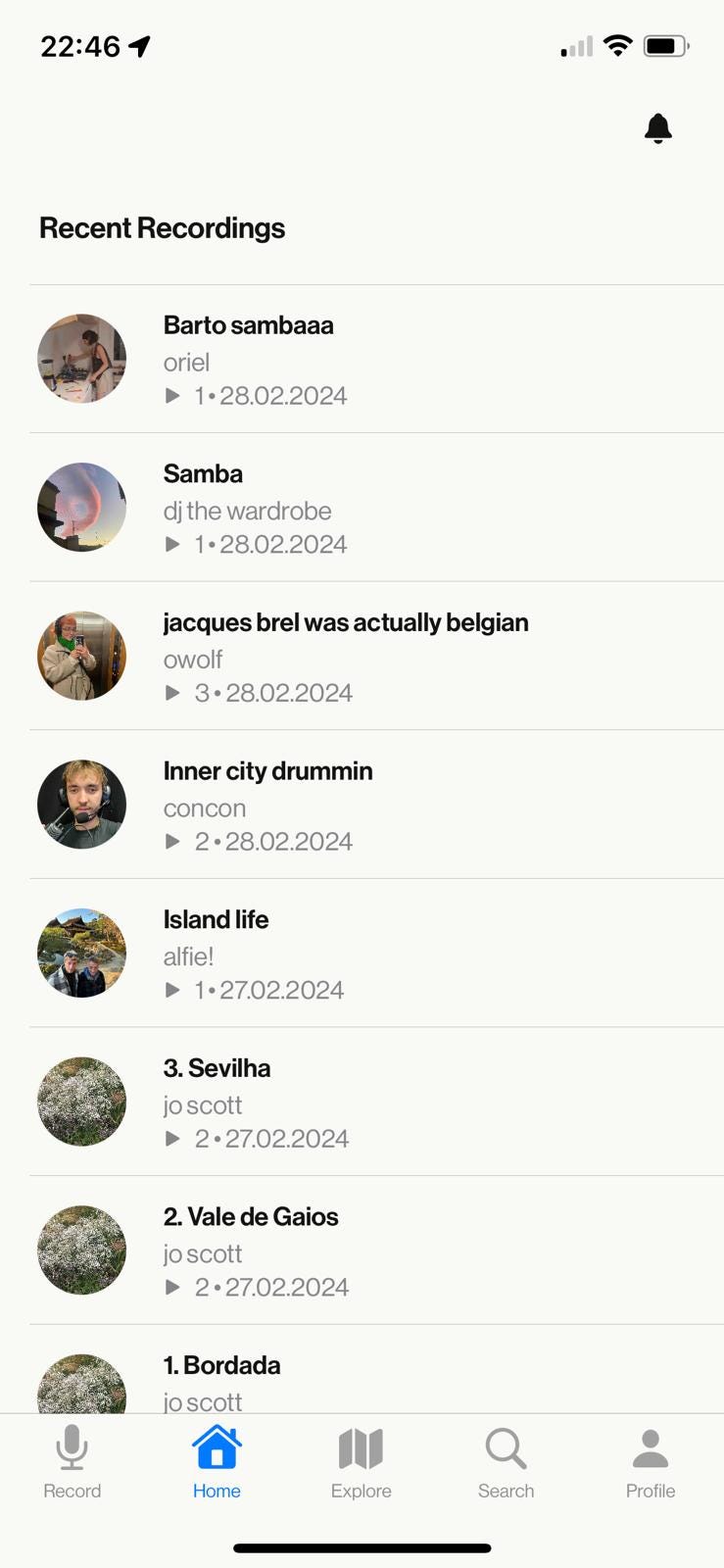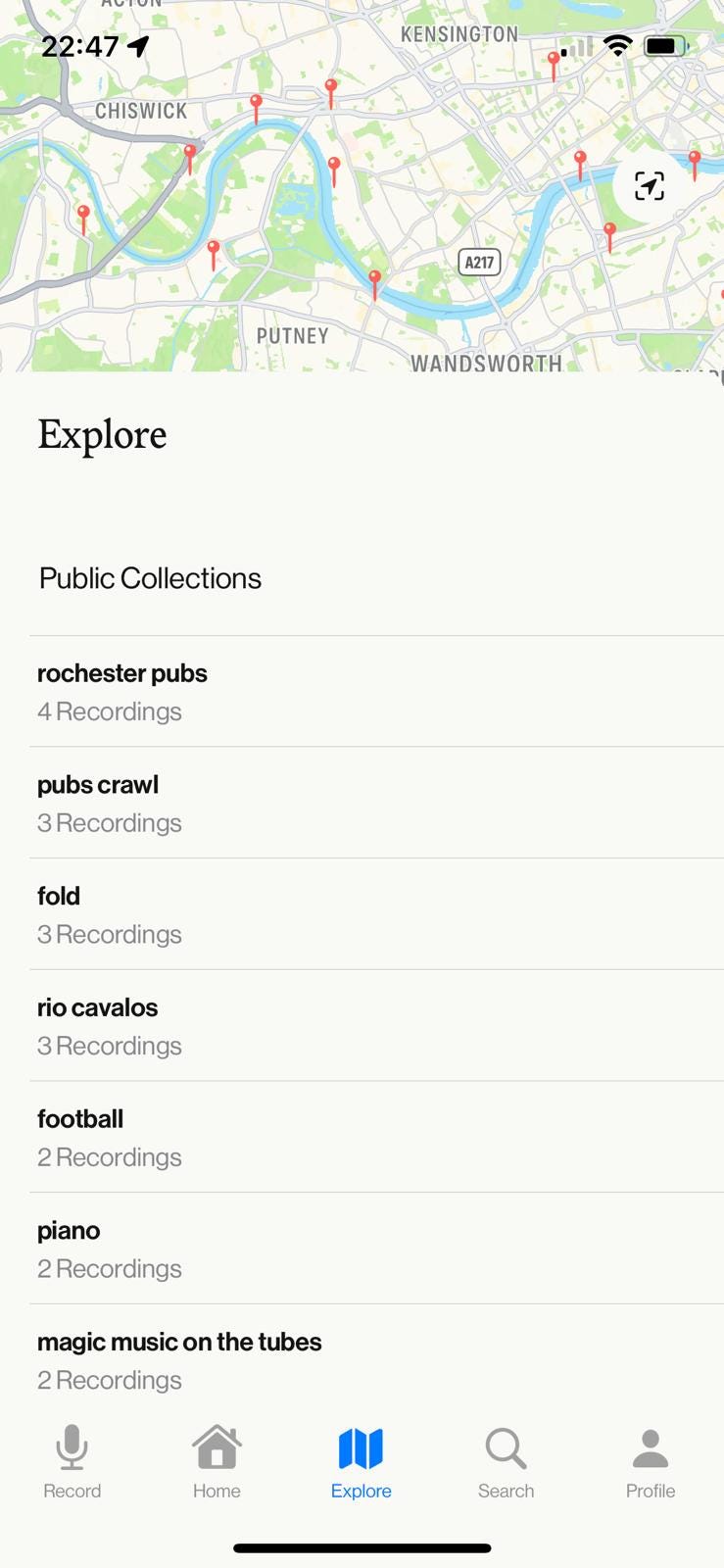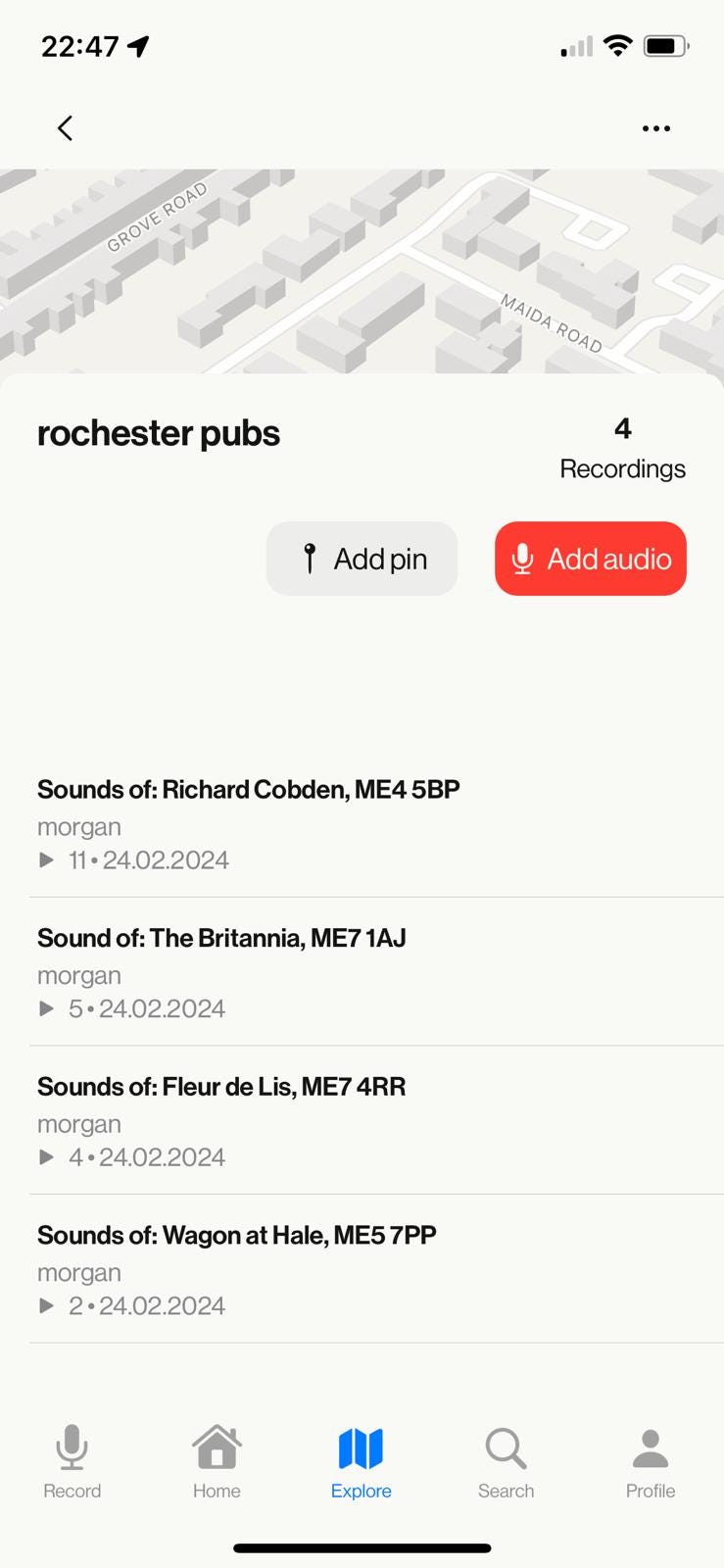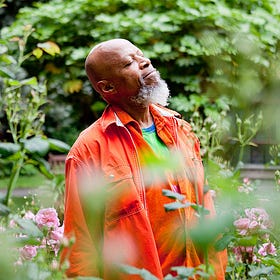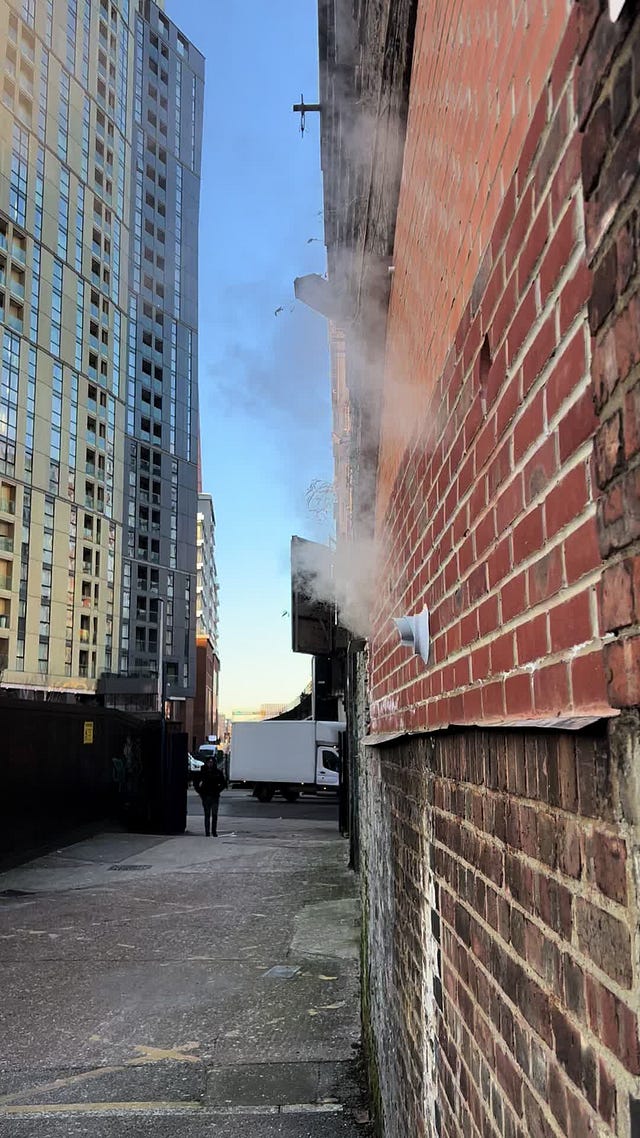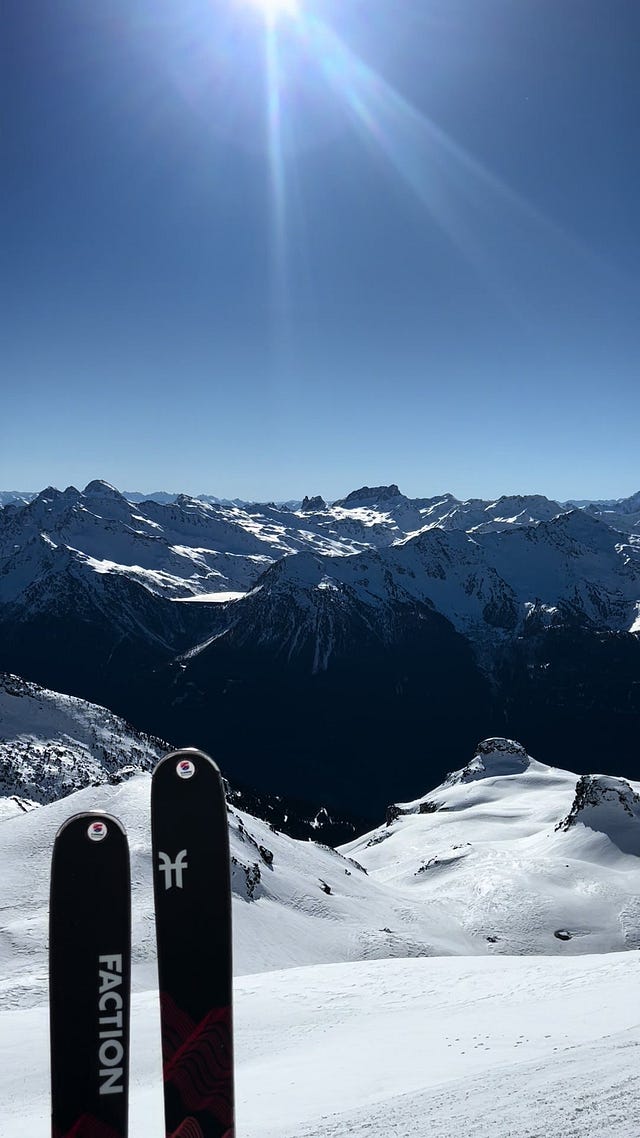AudioSpaces #2
February 2024. Collections, reflections, and announcing the first AudioSpaces theme.
I suspect some of you will be pleased to see the end of this month; it’s been a tough one for many of us, in a number of ways. For us here at AudioSpaces, February’s embrace has come and gone with some exciting new developments, and plenty of cause for reflection.
As always, thanks and a big hello to all our new friends—whether that’s everyone who has downloaded the app this month, our new readers here on Substack, or of course those of you following our other platforms.
Beyond the rising numbers, what has really touched us recently is the level of engagement from all of you, old and new. The creativity we’ve found in the audio you’ve all been sharing has been a delight. In that spirit, let’s start today by previewing some favourites from the month.
AudioSpace(s) of the month
There’s lots to choose from, so it was a real task picking our highlights. Amongst our February favourites can be heard a range of nature’s ticks and mutters: from the squelch of a dog’s paws in the London mud to various birds in call and scrunchy leaves all across wintry Britain.
We also hear up-close the bubble of cooking gochujang sauce, ghostly echoes of a woman’s call in a La Paz bus terminal, instructions for a typical Brazilian dish, and Lio’s beautiful cover of one of my new favourite Natalia Lafourcade songs.
Don’t forget that these can all be previewed in the app, and of course they can be listened to in their full glory by going to their pinned locations IRL. For those of you who still don’t have access to the AudioSpaces app, find the previews of these highlights as Reels on our Instagram.
1. Noble fair maiden amidst the backdrop of the birds on a clear evening overlooking the lake
by thorlo
2. Bubbling gochujang for my mushies
by concon
3. Pasan los Dias - Lio (Natalia Lafourcade cover)
by jody
4. Chicken with farofa recipe
by alexander
5. La Paz Terminal
by cb888
6. Starling roost, Govanhill, Glasgow 7.30am 11 Feb 2024
by tim nunn
7. Leaves need a gentle touch
by hello
8. Dog on Walthamstow Marshes
by siobhan
Big ups
I’ve said it before: what we’re doing here, of course, doesn’t exist in a vacuum. Our influences come from various places, and there are lots of amazing projects, organisations and productions that we’re proud to exist in the same space as.
It’s probably worth, then, giving some recognition to just a few of the things that we’ve been enjoying this month. Don’t miss any of these out.
1. Sonic Tapestries
Right from the start of my own personal Substack journey as a reader, one publication I’ve always enjoyed has been Mat Eric Hart’s Sonic Tapestries. Originally starting life as a radio series a few years ago, the Substack has become a written output for the artist’s explorations in and about sound.
Follow him for easy access to a huge amount of soundscape work, ambient mixes and reflections such as this fascinating recent one about the sounds that mountains (literally) make.
2. Resonances of Resistance: Sonidos experimentales para Gaza
Published by the Spanish República Ibérica Ruidista (Murcia, Spain) and available for free download, this compilation is the product of a call-out by the artist Sergio Sánchez
The lengthy album (83 pieces, wot) sees Spanish-speaking musicians collaborate with artists from Gaza, bringing together an eclectic, at times passionate mix of ambience, improv and experiment. There’s an emphasis on testimonies, recorded and found sounds—all as an act of solidarity with the people of Gaza, and Palestine more generally.
The details of the what is reasonably being called a genocide taking place in Palestine go beyond the reach of today’s newsletter. What we can do, though, is echo the words of the collective themselves: “All help, even if symbolic, is necessary”.1
3. Pandemic Sensory Archive
Finally, brought to my attention in a great article by Emily Collins for the Sounding Out! blog, is this unique project by William Tullett and Hannah McCann. The concept is straightforward: to explore the way we experienced the pandemic through our five main senses. It takes the form of an open archive that anyone can add to, and is visualised in the form of a sensory map.
Some of us would probably rather not think about those couple of years, but it may be worth revisiting some day. One way of dealing with difficult and complex memories is through focusing on how those times felt—including sensorially. You may find a lot to identify with, so maybe one to bookmark.
New in the app
Last month saw some changes to the design of the app, and we’ve made a few crucial tweaks again. Ollie works making improvements to the app at a rate that never ceases to amaze, and props to him—it’s both more powerful and easier to use than ever.
Now you’ll find a feed of AudioSpaces shared by those you follow on the Home tab; a quick click onto any of these and you’ll be sent straight to the recording’s location for a 20 second preview. The Explore tab stays the same as before, allowing you to freely discover the totality of AudioSpaces added to date on an open map.
The addition you're most likely to notice, though, will be the new Collections feature. You’ll first come across this after you make a recording, being given the option to create a collection for your new AudioSpace, or to add it to an existing public collection.
Think of a collection as the way to group different AudioSpaces according to a given particular theme, project or narrative. This can be taken in any direction you might like, and we’re already seeing a few great user-made collections.
In the Explore map, you can browse all the available collections made to date, and add more audio into them (if they’re public) through this page, too.
Also in the Explore tab you’ll find another exciting part of Collections: any given collection can be gathered together and pinned to a whole separate location from those of their original individual AudioSpaces. Just tap Add pin and choose your preferred place on the map.
What does this mean? Well, we can now create entirely new listening spots for groups of AudioSpaces around the world, enabling us to bridge our listening experiences across very different contexts.
As we develop the Collections feature further, what we envisage is the potential for easily setting up listening parties, exhibitions, sound walks and more—all the while being able to maintain each AudioSpace’s link to its original pinned spot.
We’ll never stop saying it, but AudioSpaces will always aim to be as collaborative a project as possible. We’ll bring you along with us, both as we make changes to the app and as we develop our general outlook. Never hesitate to contact us for feedback on any of our platforms or at oliver@audio-spaces.com.
February’s posts
In case you missed them, here are a few of our recent additions to our Substack.
What audio? Whose map?
The question "what do I record?" is a fair one that many of you ask when you first learn about AudioSpaces. This could be answered with a simple list of suggestions, but it's also a question that invites us to consider the politics of recording audio. What should we be recording, how and why? In this article we explore how certain kinds of listening, recording and map design have, over time, become favoured over others.
Listening's pleasure
Recording audio has a lot to do with the practice of listening. For me, this isn't just about listening for a specific, external purpose, but also about opening our ears to the world as an activity in itself. Learning to listen is something that can bring great joy, connect us with our environments and strengthen our relationships through deepening our acoustic communities. Here we touch on why a habit of recording the sounds around us is a perfect way to begin to listen more.
As promised, we've also already began our new Traces series. These micro-essays are experiments in capturing those sounds there are no longer there in the material world—or perhaps never even existed outside our imaginations. Describing the sounds that echo in our heads can be a challenging task, but to me this suggests that it's something worth doing.
You're now and forever invited to submit your own Traces. There are no rules for what you might like to contribute, so come join in building this archive of sonic residue. Here's an example that's close to home for me: the tick of my grandmother's old clock, which rings as clearly in my head now as it did when I was a child.
As well as all the stuff on Substack, Seb’s been at it again over on TikTok, continuing to document the moments and places that bring our ears into dialogue with the world. Don’t forget to follow us there, and on Instagram too.
 Tiktok failed to load.
Tiktok failed to load.Enable 3rd party cookies or use another browser
Wellbeing: our first theme
What we’ve been trying to do so far with our posts is to reveal the different ways we can think about sound in all its glory as something social, technological, political, creative, ecological and personal. There are so many aspects to how sound—both as it propagates in space around us and in its recorded audio forms—affects our lives.
Part of the idea behind these reflections is to deepen our listening and open up the sense of possibility for how we might want to use the AudioSpaces app. You probably know by now that one of our goals is to make audio practices accessible to those who are interested in saving and sharing the sounds around them, but have never considered themselves a field recorder, artist, archivist or musician.
Rather than just a bunch of “how to” articles, though, we always wanted this space on Substack to be one in which we can think deeply and explore all these issues together. We’ll carry on with this task, which will get even more interesting as we roll out guest articles and other collaborations.
So, we’ve gotten most of our introductions out of the way over the past couple months, and AudioSpaces is genuinely up and running. It might be useful now to bring a bit of coherence and purposefulness to our adventures here, and think about all things sound according to specific themes.
Considering the great feedback we got from our last article we thought a suitable first theme to go with would be wellbeing—understood in its broadest sense, from the personal and the intimate, to the social and societal, all the way up to the ecological and caring for nature.
For the next little while, then, the concept of wellbeing will be a common reference point for a lot of what we publish here in the newsletter. It will also colour much of our activities with the AudioSpaces app for a while, from dedicated collections to standalone projects and in-person events (some of which we’ve already piloted—keep posted for more info very soon).
Don’t get the wrong idea, though: the point of the theme is not to determine how you might want to engage with AudioSpaces yourself. That’s always for you decide. And don’t worry, it’s also not that we’ll only be discussing wellness and therapy here, or anything like that.
Our themes will never be limiting, but simply a guide—a prompt for all of us, in whatever way we engage with AudioSpaces, to consider (in this case) how sound and wellbeing blend and interrelate in our daily lives. We’re excited to see how this one develops as time goes on. Take it easy x
If you want to help more tangibly, they also opt to ask for donations for the UN’s refugee agency UNRWA, who work for a future of dignity and freedom for Palestinian refugees. That link goes directly to the agency’s donation page; I’d of course always suggest taking time to look into the organisations to which you decide to donate. Edit 31st March: the UK government has recently removed support for the UNRWA under highly questionable premises, and in response I wholeheartedly reaffirm the need to support the agency for the vital work they are doing in Palestine.







